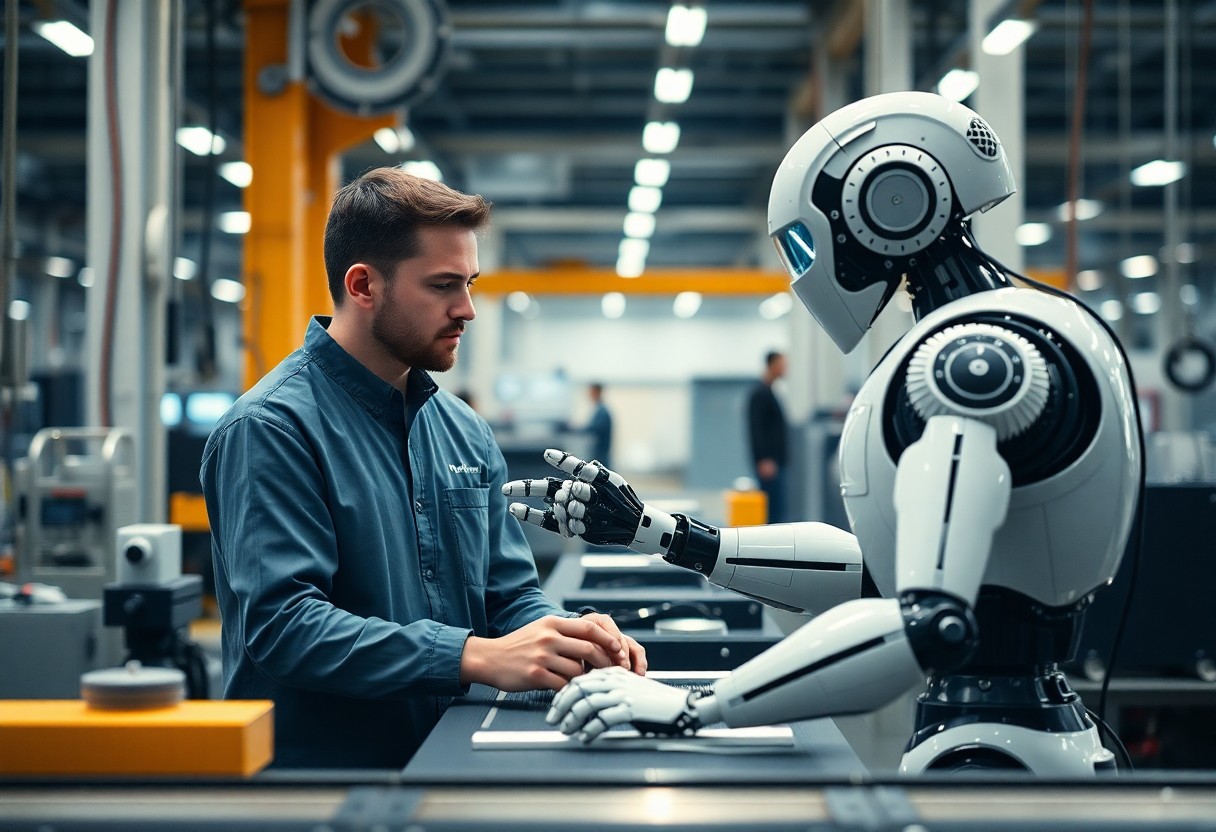Human-Robot Collaboration – Transforming Manufacturing And Beyond
Smart Cooking Tips For Perfectly Balanced Meals Every Time
March 19, 2025The Role Of AI In Human-Robot Collaboration
March 20, 2025There’s a fascinating evolution happening in the world of manufacturing as human-robot collaboration paves the way for unprecedented efficiencies and creativity. You may be surprised to learn how these partnerships not only enhance productivity but also improve safety by taking on hazardous tasks that can jeopardize human workers. In this blog post, you’ll discover how this transformative approach is reshaping not just factories, but also various industries beyond manufacturing, leading to innovative solutions that enhance quality of life and accelerate advancements across the board.
The Evolution of Human-Robot Collaboration
A fascinating journey has unfolded in human-robot collaboration, reshaping manufacturing and numerous other industries. From rudimentary automation systems to sophisticated collaborative robots, or “cobots,” the landscape of cooperation between humans and machines has dramatically changed. You can now leverage these innovations to enhance productivity, safety, and efficiency in your workplace.
Historical Perspective
Around the mid-20th century, robots began to emerge in industrial settings, primarily performing repetitive tasks in manufacturing. Initial implementations were rudimentary, often requiring complete isolation from human workers for safety. Your understanding of this evolution underscores the growing synergy between humans and machines as technological capabilities expanded.
Key Technological Advances
For decades, advancements in robotics and artificial intelligence have paved the way for a new era of human-robot collaboration. These developments have improved safety protocols, allowing for more direct interaction between robots and human workers. You can now benefit from smart sensors, enhanced machine learning algorithms, and adaptive systems that work alongside you in real-time.
Due to these technological advancements, the workplace has shifted significantly. With the integration of smart sensors, robots now have the ability to perceive their surroundings, ensuring enhanced safety when working alongside humans. Additionally, machine learning algorithms enable robots to adapt to your tasks, increasing efficiency and reducing the errors that can occur in repetitive tasks. Furthermore, the development of collaborative robots means that these machines are designed specifically to function as your assistant, promoting a more harmonious working environment that boosts overall productivity. These advances are reshaping not only manufacturing but also various sectors, offering endless possibilities for innovation and growth.

Current Applications in Manufacturing
Now, the integration of robotics and automation in manufacturing has reached new heights, optimizing productivity and efficiency across various sectors. Companies are increasingly adopting robotic systems to streamline operations, enhance safety, and reduce labor costs. As a result, you can expect improved workflows and reduced human error, allowing your workforce to focus on more complex tasks that require creativity and critical thinking.
Robotics in Assembly Lines
At the heart of modern manufacturing, robotics in assembly lines enable seamless and efficient production processes. These advanced machines can operate at high speeds while maintaining precision, greatly reducing the time taken to assemble products. By incorporating robots in your assembly lines, you gain the advantage of consistent output quality and minimized operational downtime.
Quality Control and Inspection
Among the many benefits of robotics in manufacturing, quality control and inspection stand out significantly. Automated systems equipped with advanced sensors and artificial intelligence can perform high-speed inspections with exceptional accuracy, which drastically reduces the risk of human error. This ensures that only products meeting your standards make it to market.
Indeed, leveraging robotic technology for quality control and inspection delivers a transformative impact on manufacturing processes. These systems are designed to detect defects and inconsistencies effectively, enhancing your product reliability. By deploying robots for these tasks, you not only minimize the chances of faulty products reaching consumers but also free up skilled workers to focus on other crucial activities. Importantly, this leads to larger savings on warranty claims and enhances overall customer satisfaction, giving you a competitive edge in the market.
Enhancing Worker Safety and Productivity
Some industries are witnessing a transformative shift with the integration of collaborative robots, or cobots, which are designed to work alongside you and your colleagues. By leveraging this technology, companies are not only improving Cobots in Manufacturing: A New Era of Human-Robot … but also enhancing overall safety and productivity within the workplace.
Reducing Occupational Hazards
About the incorporation of cobots directly addresses the prevalent challenges of workplace injuries, allowing for a safer environment. By handling repetitive and physically demanding tasks, these robots significantly reduce the risk of accidents, empowering you to focus on more complex and engaging responsibilities.
Boosting Operational Efficiency
Around the world, businesses that adopt cobots experience significant gains in operational efficiency. By automating tasks, you can ensure faster production times and minimize human error, leading to higher quality outputs and satisfied customers.
Even companies are reporting increased throughput and reduced downtime thanks to cobots. This technology allows you to streamline processes and facilitate smoother workflows, providing you with more time to innovate and enhance your skills. The synergy between you and your robotic partners creates a dynamic work environment where safety is prioritized, and productivity soars. As a result, you can achieve greater job satisfaction while contributing to the overall growth of your organization.
The Role of Artificial Intelligence
All industries are witnessing a significant transformation due to the integration of artificial intelligence (AI) into their processes. In manufacturing, AI enhances efficiency, reduces operational costs, and improves safety by automating routine tasks and enabling real-time data analysis. Your organization can leverage AI to allow robots to adapt to changes in their environment, resulting in increased productivity and a more agile manufacturing system.
Machine Learning in Robotics
Before delving into the specifics, consider how machine learning enables robots to learn from data and improve their performance over time. By analyzing past experiences, robots can adapt their actions to optimize various manufacturing processes, making them more efficient and reliable. This ability transforms robotic systems into intelligent partners that complement your workforce.
Intelligent Decision-Making
On the frontier of AI, intelligent decision-making represents a game-changer for your operations. The integration of algorithms allows robots to make informed choices based on real-time data, improving workflow and resource allocation. This not only enhances productivity but also minimizes errors, ensuring a smoother manufacturing process.
Learning from vast data sets, machine learning empowers robots to identify patterns and trends, allowing them to make quick and accurate decisions. For you, this means reduced downtime and improved output, as robots can respond to changes and challenges without human intervention. Moreover, intelligent decision-making improves not only operational efficiency but also safety in the workplace, creating an environment where risks are managed effectively. As technology evolves, harnessing these AI capabilities can position your organization for a successful future in manufacturing and beyond.
Challenges and Considerations
To effectively implement human-robot collaboration in manufacturing, you must navigate several challenges and considerations. These include addressing safety concerns, ensuring seamless integration of technologies, and managing the change resistance among your workforce. Additionally, it’s imperative to maintain open communication about the role of robots in your operations to foster trust and maximize productivity.
Ethical Implications
For any technological advancement, ethical considerations cannot be overlooked. You should reflect on the implications of deploying robots in workplaces, particularly regarding job displacement, data privacy, and decision-making autonomy. A transparent approach to these issues can help you build a framework that respects both employee rights and technological innovation.
Workforce Impact and Skill Development
Above all, the integration of robots in manufacturing environments necessitates a shift in workforce dynamics. You will need to assess how robotic systems impact workforce roles and what training programs are required to upskill employees. This evolution can lead to new job opportunities in areas where human expertise is still invaluable.
Implications of workforce impact are profound. With automation advancing, you may face shifts in jobs that demand higher technical skills, leading to a potential skills gap within your workforce. Conversely, embracing robotic technology offers a chance to enhance employee productivity and create exciting new roles focused on oversight of automated systems. Prioritizing employee training not only equips your team with vital skills but also cultivates a forward-thinking workplace culture that can adapt to ongoing technological changes.
Future Trends in Human-Robot Collaboration
After years of incremental advancements, the future of human-robot collaboration is set to redefine manufacturing landscapes. You will witness a surge in smart robotics that are capable of advanced machine learning, enhancing their ability to work alongside you efficiently. This evolution will not only streamline operations but also allow for greater adaptability in various industries. As technology continues to progress, your relationship with robots will become increasingly integrated, reshaping job roles and productivity benchmarks.
Innovations on the Horizon
At the forefront of human-robot collaboration, you can expect innovations such as collaborative robots (cobots) equipped with enhanced sensory perception and artificial intelligence. These technologies will provide you with tools that understand and respond to your actions in real-time, making your interactions smoother and more intuitive.
Potential New Markets
HumanRobot collaboration is rapidly paving the way for new markets beyond traditional manufacturing, expanding into healthcare, logistics, and even agriculture. As robots become more sophisticated, you’ll find their applications catering to diverse sectors where efficiency and precision are paramount.
Considering these developments, you should explore the potential of human-robot collaboration in industries like healthcare, where robotic assistants can aid in patient care, or in agriculture, where automation can enhance crop yields. The rise of robots in logistics will optimize delivery systems, drastically reducing costs and improving speed. As companies embrace these innovations, your job landscape will expand, presenting exciting career opportunities and requiring upskilling to work alongside advanced technologies. You will find that as robots take on repetitive tasks, you can focus on more strategic and creative roles, positioning yourself at the forefront of this evolving workplace.
Summing up
Conclusively, embracing human-robot collaboration can significantly transform your manufacturing processes and beyond, enhancing productivity and safety. By integrating advanced robotics with your skilled workforce, you can unlock new efficiencies and foster innovation in your operations. As you navigate this technological evolution, you’ll find opportunities that not only streamline tasks but also empower your employees to focus on higher-value activities. Your proactive approach to this partnership will undoubtedly lead to a more dynamic and responsive manufacturing environment.
NEWSLETTER






